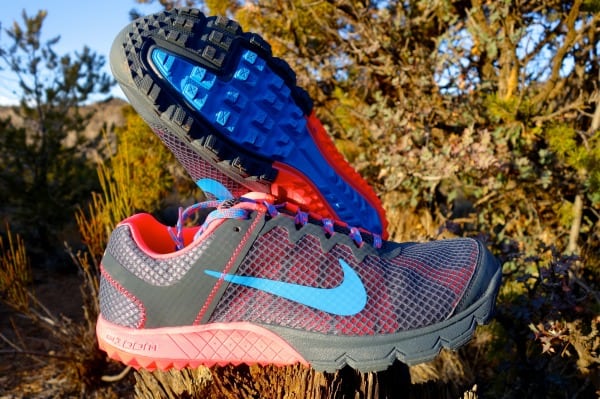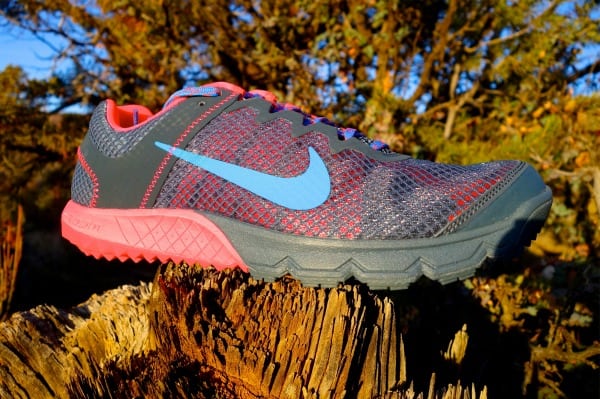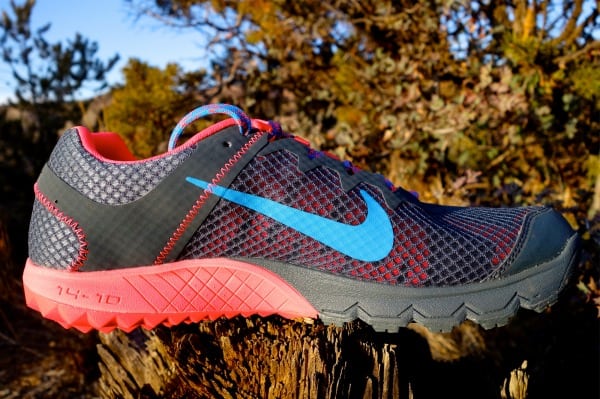Check out our Nike Wildhorse 10 review for the latest on the Wildhorse family of trail running shoes.
Our Favorite Trail Running Shoes
Check out our Best Trail Running Shoes article to learn about our current favorite trail running shoes!
Nike Zoom Wildhorse Review
With the release of the Nike Zoom Wildhorse ($110) and Nike Zoom Air Terra Kiger (full review) in late 2013, Nike hopes to legitimately reenter the trail running market. In the recent past, Nike has simply added some reinforcements to the upper and a heavier-lugged outsole to established road shoes such as the Pegasus or the Structure Triax, and these two shoes spell the first time in recent history that they have engineered a dedicated shoe aimed at tackling trails.

I will admit that when I received these shoes, I didn’t want to like them. Nike is a worldwide behemoth with access to materials and funds for the sort of research and development that I’m sure many smaller trail-shoe companies can only dream of. But, let’s remember that almost all trail running shoes are made in one of several factories in China, so it’s not really necessary to delve into a diatribe about Nike and globalization like the protesters outside of my college track locker room. I will say that Nike seems to be taking trail running very seriously and that this shoe is a fully realized, well designed, lightweight trail machine that deserve a look from even the most discerning brand loyalist.
Initially receiving a bit less of the hoopla, the Wildhorse is the slightly heavier (8.4 ounces) and more protective of the two shoes. With a 4mm drop and decent flexibility, the Wildhorse is definitely a contender in the minimalist/lightweight category.
Upper
First, forget any preconceptions about how Nike running shoes fit you. This fit is very different and features a snug, but not tight, heel which slowly widens throughout the upper into a pleasantly wide toe box. The fit through the midfoot is kept from being sloppy by the use of a Dynamic Fit system which uses a no-seam sleeve that hugs the mid foot and acts like a gusseted tongue. A simple lacing system which cinches well and the middle-of-the-road fit of this shoe will accommodate a lot of different foot types.
A tough, synthetic-leather toe bumper bolsters a basically seamless upper which is made of a dual-density mesh over a midfoot wrap which is controlled by the lacing system. There really isn’t anything here you haven’t seen before, but the use of great materials in a completely functional (read not flashy) way won me over very quickly.

Midsole
Nike used their popular Phylon midsole foam from heel to toe on the Wildhorse and the effect is a semi-firm ride which is a touch more firm than expected at first. This midsole material recently re-emerged three years ago when Nike reintroduced their Zoom Elite series road shoe and the Phylon foam resists compression and is hard enough to alleviate the need for a rock plate. Initially, I was chagrined about not having additional protection, but I have yet to feel a rock through the forefoot. A Zoom air pocket in the heel makes the ride feel a bit more plush.

Outsole
At first glance, the outsole on the Wildhorse is underwhelming, but after several runs I began to appreciate its genius. A beveled heel allows for better stability on uneven trails, and Nike uses a sticky, pyramid-shaped rubber compound around the heel. In the center of the heel section of the shoe are lugs angled to help control downhill running. The forefoot of the Wildhorse uses Nike’s standby waffle sole design but angles the lugs back toward the heel to aid with traction on the uphills.
Nike uses their Environmentally Preferred Rubber throughout the outsole which reportedly contains 98% less toxins by weight than original rubber.

Overall Impression
The Zoom Wildhorse is a well engineered and highly functional trail shoe that I certainly wasn’t expecting to come from Nike. I took this shoe out daily in a variety of wintry conditions from snow pack to ice to sticky red clay. I really couldn’t find a surface that the Wildhorse didn’t perform well in. This shoe is a great all arounder in the same vein as a Saucony Peregrine, Pearl Izumi Trail N1, or Inov-8 Trailroc 245, but is nearly an ounce lighter. It seems that Nike engineers took their time with this shoe, letting other companies refine what works and what kinds of features top runners want in a shoe, and then put out exactly that without any extra frills.
The Wildhorse offers a surprising amount of semi-firm cushioning in a lightweight package, and given the reasonable $110 price and great durability so far, I imagine that trail runners will see a lot of this shoe on the feet of their friends and competitors in 2014. Given the addition of the new Nike Trail Team, I think that Nike is seriously in the game and here to stay.
Call for Comments (from Meghan)
- Have you tried the Zoom Wildhorse yet? What are your initial thoughts on this shoe and the effort Nike has put into it?
- If you’ve tried one of Nike’s previous ‘trail’ shoes, how would you compare the Zoom Wildhorse to those predecessors, fit-wise?
- And, what about the Zoom Wildhorse’s outsole? What kind of conditions have you tested it in and how did it perform?
